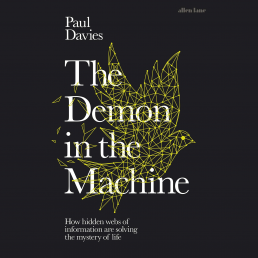06-Feb-2019
On 05-Feb-2019 Royal Institution welcomed theoretical physicist/cosmologist/astrobiologist Paul Davies to give a lecture promoting his new book “The Demon in the Machine”.
The main themes of the lecture were “life as an informational process” and “how did life begin?”. We got a number of fascinating insights on the former, while for the latter… no, we still don’t know for sure. What was rather unique about the lecture was that it was more like an interdisciplinary discourse between some of the greatest minds in the history of modern science (Schrödinger, Crick, Maxwell, Shannon, Einstein) in which Prof. Davies was a contributor and a moderator rather than a monothematic first-person speech. And I loved it.
The lecture, with intro from esteemed Prof. Jim Al-Khalili himself, started somewhat philosophically, with Prof. Davies opening up with 2 questions-statements which would set the tone for his entire lecture:
- We can’t define what (exactly) life is
- We don’t know how it began on Earth

Professor Davies started by referencing Erwin Schrödinger’s seminal “What is Life?” and Francis Crick’s “Life Itself: Its Origin and Nature” (“An honest man, armed with all the knowledge available to us now, could only state that in some sense, the origin of life appears at the moment to be almost a miracle, so many are the conditions which would have had to have been satisfied to get it going”) and his own work in SETI Programme (Search for Extraterrestrial Intelligence), whose struggle is to find any life in the universe and thus (indirectly) answer the question: does life start easily? One of the current schools of thought posits that the universe should be teeming with life, and yet we have not yet found any evidence of it (Fermi’s Paradox). In the context of search for extraterrestrial life, Prof. Davies remarked that science requires a “life-meter”, which would enable it to determine not just whether a given organism is living or not (something we can do fairly well today, at least in terrestrial context), but also whether given system (e.g. planet or moon) is “on its way” to develop life, and if so, how far down the road it is.
Moving on to the main theme of his lecture, Prof. Davies remarked on the difference in ways scientists define life: physicists would talk about life in the terms of matter, force, energy, reaction rates, molecular binding etc. (“hardware speak”), biologists would define it in the sense of ribosomes, amino acids, genetic code, coding instructions in genes, transcription, gene editing and otherwise use the language of information (“software speak”).
Continuing to focus on the language of information, Prof. Davies discussed whether we can define what exactly information is and whether the biology of living systems (e.g. humans) could be mapped in the form of computer science logic. That, he said, could open up the possibility of “fixing” such issues as cancer, treating it the same way as corrupt software on a computer. He further discussed whether information as such as real, leaving the question open, but concluding scientists *do* consider information as real. From this vantage point, Prof. Davies raised the question as to how information (defined as bits and bytes) can have impact on matter, which led him to Christoph Adami’s definition: “Information is the currency of life. One definition of information is the ability to make predictions with a likelihood better than chance”. He further referenced Claude Shannon’s seminal work, in which information was defined as a reduction of uncertainty.
In the end, we didn’t get any closer to understanding how exactly life began, but some of the connections and observations Prof. Davies made between well-known and not-so-well-known theories and discoveries were truly fascinating and made for great food for thought, which is what popular science should be all about. His enthusiasm and energy shone through, while the ability to facilitate the one-man discourse among different branches of science (biology, physics, astrophysics, information theory) is – to me – what makes the difference between a good scientist and a great one.
